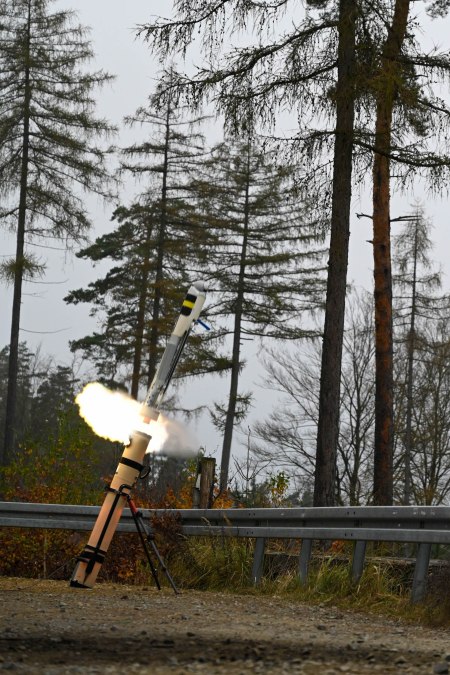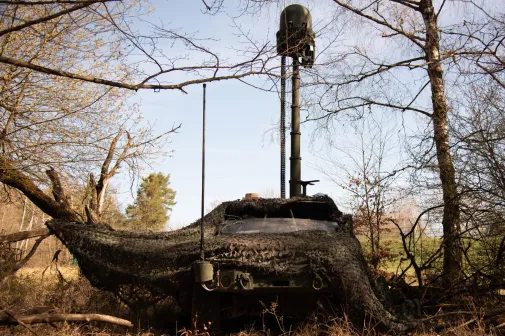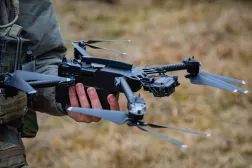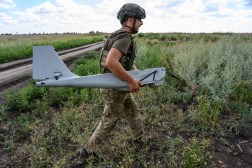Army’s fiscal 2026 budget proposal aims to equip infantry brigades with more kamikaze drones

The Army is requesting nearly $70 million to procure hundreds of all-up rounds and fire-control units for loitering munitions in fiscal 2026 under the Low Altitude Stalking and Strike Ordnance program, according to new budget documents released this week.
LASSO — which was a new-start program in the previous budget — is now part of the service’s Launched Effects family of systems and has been realigned under that line item in the 2026 budget.
Drone maker AeroVironment has been manufacturing Switchblade systems for the initiative. The Switchblade 600 carries high-precision optics and an anti-armor warhead. It has upwards of 40 minutes of loitering endurance, a range of 40-plus kilometers, and a “sprint speed” of 185 kilometers per hour, according to a product description from the vendor. The all-up round weighs 65 pounds.
The request for additional loitering munitions — also known as kamikaze drones or one-way attack drones because they’re designed to destroy their targets by crashing into them — in 2026 comes as officials are undertaking a new Army Transformation Initiative to modernize the force for future high-tech combat. The service is moving to divest of capabilities that are outdated and put more money into other equipment.
“The Army Transformation Initiative, or ATI, as we’ve coined it, is a strategic shift. We’re reinvesting resources to ensure our future dominance as part of the joint force,” a senior Army officials told reporters Thursday at the Pentagon during a background briefing about the budget. “We made some tough choices to shed outdated systems and programs that no longer meet our demands of the modern battlefield,” including divesting from legacy anti-tank missiles, they noted.
Kamikaze drones have played a major role in the Ukraine-Russia war, and U.S. military leaders are taking lessons from that conflict as the seek to modernize their forces.
The Army is aiming to deliver five brigade combat teams-worth of loitering munitions in fiscal 2026. The budget request includes about $68 million for 98 fire control units, 294 all-up rounds and other program elements under LASSO. Nearly $13 million in reconciliation funding would procure an additional 19 LASSO production systems.
“Infantry Brigade Combat Teams (IBCTs) lack adequate proportional organic capabilities at echelon to apply immediate, point, long range, and direct fire effects to destroy tanks, light armored vehicles, hardened targets, defilade, and personnel targets, while producing minimal collateral damage in complex terrain in all environmental conditions,” officials wrote in budget justification documents.
Army leadership wants to give troops new kamikaze drones to fill that capability gap.
The man-portable LASSO is a day/night capable, lightweight, unmanned aerial anti-tank weapon that includes an all-up round and fire control system, according to an Army description of the technology.
“The LASSO range requirement is to fly less than or equal to 20km (straight line with auxiliary antenna) with a flight endurance that enables the Soldier to make multiple orbits within the IBCT typically assigned battlespace, to acquire and attack targets within and beyond current crew served and small arms fire. The range/endurance enables the unit to utilize reach back capability and maximize standoff. Unlike existing direct and indirect fire weapon systems, LASSO’s discreet payload and unique capability delivers Soldiers the ability to abort against targets in a dynamic situation (e.g., use of human shields) or prosecute targets that would have been deemed non-viable in past due to the higher collateral damage associated with alternative munitions,” according to budget documents. Follow-on increments are expected to support capabilities for company and below echelons, focusing on increased range, enhanced lethality and advanced payload options.
Officials noted that the program is aligned with ATI and Secretary of Defense Pete Hegseth’s directive for Army transformation and acquisition reform.
It’s also intended to support the Army’s transforming-in-contact initiative — an effort spearheaded by Chief of Staff Gen. Randy George with a particular focus on unmanned aerial systems, counter-UAS and electronic warfare capabilities — and expand prepositioned stocks in the Indo-Pacific region, where the U.S. military is concerned about a potential future conflict with China.
The LASSO program will use other transaction authority for contracting, which is intended to cut through bureaucratic red tape and help the military field new technologies faster than traditional acquisition processes. Officials also intend to award up to four hardware contracts to modernize the industrial base and generate domestic ammunition stockpiles, according to budget documents.






